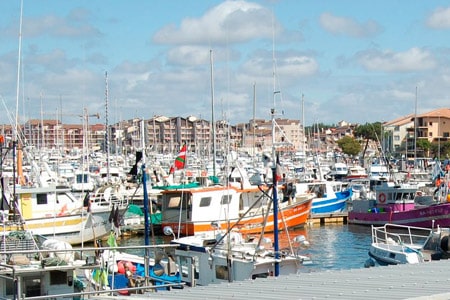In the south of the Landes, 15 minutes from Lou P’tit Poun campsite ****, Capbreton is a historic seaside resort bursting with energy. It’s a surfer’s paradise… but not the only one. Here’s a rundown of places to visit in Capbreton!

Morning: the port and the pier
Located 15 km from your
campsite rental in the Landes
Capbreton offers a multitude of places to visit. Did you know that Capbreton is the only port in the Landes region? Although today’s fishermen no longer hunt whales as they did in the days of the Terre-Neuvas, Capbreton remains a dynamic fishing port, as evidenced by its
fish market
.
Every day from 9 a.m. to noon, and from 3 p.m. to 6 p.m., fishermen sell their fresh fish directly on the quay, without going through the fish auction. This is your chance to fill your basket “at the boat’s ass”, with beautiful sea bream, bonito, sole, sea bass, hake, squid and chipirons. You can also try fishing them from the top of the famous pier.
Just a stone’s throw from the port, Capbreton ‘s Estacade is one of the resort’s picture postcards. Built by Emperor Napoleon III in 1858, the almost 200-meter-long wooden jetty has become a popular promenade for tourists and locals alike, and a favorite spot for anglers.
A few hundred metres off the Estacade lies the
the Capbreton “Gouf
a geological curiosity at a depth of over 4,000 metres. It’s an underwater canyon comparable to Colorado’s Grand Canyon. Legend has it that the underwater valley is inhabited by strange creatures such as the giant squid.
Afternoon: Capbreton’s historical center
One of the best ways for tourists to get to know the city and its history is to take a stroll through the city center. Let your footsteps guide you along the streets and alleyways known here as “balènes”, and discover some of the architectural gems to be found in this charming port city of the Landes region.
A stroll through the town center, and in particular the “Grand rue”, reveals two medieval half-timbered corbelled houses nicknamed “Maisons des Anglais”, in reference to the presence of the English in Aquitaine from the 12th to the 15th century. Walking up the pedestrian street, you pass the Maison de l’Oralité et du Patrimoine, a restored 16th-century mansion that now houses a permanent collection dedicated to the history of “La ville aux cent capitaines”.
A little further on, we are reminded of history in front of the Maison du Rey. It was here, in this modest medieval building listed as a historic monument, that the future King Henri IV, then King of Navarre, slept during his visit to Capbreton in 1583. To delve even deeper into Capbreton‘s maritime past, you’ll need to visit the church of Saint-Nicolas, recognizable by its round, lighthouse-shaped tower. Inside, you’ll be able to admire beautiful murals on the theme of the sea and sailors. A remarkable set of stained glass windows by master glassworker Gustave Pierre Dagrant illuminate the nave and choir.
End of the day on the beach
Late afternoon in Capbreton is the perfect time to laze on the warm sand. Santocha beach is a favorite with families, but also with surfers in search of waves and sensations. Thanks to its
world-renowned spots
Capbreton has become a European surfing capital, alongside Hossegor and Biarritz.
A few fathoms further on, Notre-Dame beach also attracts fans of refreshing, sporty swimming. After the beach, you won’t be able to resist sampling a delicious ice cream or homemade sorbet at one of the city’s finest artisan ice cream makers: Chez Izots (opposite Estacade beach) or Xamp (avenue Georges Pompidou).
